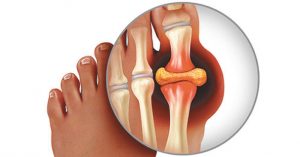By Eileen Rivero, DPM, ABPM
 Gout, often considered a disease of antiquity, persists into the modern era, afflicting individuals with intense pain and discomfort, particularly in the foot. Characterized by sudden and severe attacks of pain, swelling, redness, and tenderness, gout of the foot can significantly impair mobility and diminish quality of life. Let’s delve into the etiology, symptoms, treatment, and prevention strategies for gout, particularly as it manifests in the foot.
Gout, often considered a disease of antiquity, persists into the modern era, afflicting individuals with intense pain and discomfort, particularly in the foot. Characterized by sudden and severe attacks of pain, swelling, redness, and tenderness, gout of the foot can significantly impair mobility and diminish quality of life. Let’s delve into the etiology, symptoms, treatment, and prevention strategies for gout, particularly as it manifests in the foot.
Etiology
Gout primarily stems from the buildup of uric acid crystals in the joints, leading to inflammation and intense pain. Uric acid is a natural byproduct of the breakdown of purines, substances found in certain foods and produced by the body. Typically, the kidneys filter uric acid out of the bloodstream and excrete it through urine. However, if the body produces excess uric acid or if the kidneys fail to eliminate it efficiently, urate crystals can accumulate in the joints, triggering gout attacks.
Several factors contribute to the development of gout, including genetics, lifestyle choices, and underlying health conditions. Men are more prone to gout than women, with the risk increasing with age. Obesity, high alcohol consumption, a diet rich in purine-containing foods (such as red meat, seafood, and organ meats), and certain medications (like diuretics and aspirin) can also elevate uric acid levels and predispose individuals to gout.
Symptoms
Gout attacks often strike suddenly, typically at night, and can be excruciatingly painful. The affected joint, frequently the big toe, becomes swollen, tender, red, and warm to the touch. The pain may intensify within hours, making even the slightest movement unbearable. Some individuals may experience fever and chills during an attack, further complicating the ordeal. Gout attacks can last anywhere from a few days to weeks, subsiding gradually without treatment but often recurring unless managed effectively.
Recognition of these symptoms is paramount for timely intervention. Podiatrists are adept at diagnosing and managing gout of the foot. Through a combination of clinical assessment and diagnostic tests, including joint aspiration to confirm the presence of urate crystals, podiatrists can formulate tailored treatment plans to alleviate pain and prevent recurrent attacks.
Treatment
Effective management of gout requires a multifaceted approach aimed at both alleviating acute symptoms and addressing underlying metabolic imbalances. Nonsteroidal anti-inflammatory drugs (NSAIDs), such as ibuprofen and naproxen, are commonly prescribed to reduce pain and inflammation during acute attacks. Colchicine, a medication with anti-inflammatory properties, may also be used to alleviate symptoms, particularly in cases of intolerance or contraindications to NSAIDs.
For individuals with recurrent or chronic gout, urate-lowering therapies (ULTs) are indispensable. These medications, including allopurinol and febuxostat, work by inhibiting the production of uric acid or enhancing its excretion. Podiatrists play a crucial role in monitoring the efficacy and safety of ULTs, adjusting doses as needed to achieve therapeutic goals while minimizing adverse effects.
In cases of severe pain or joint inflammation, podiatrists may recommend corticosteroid injections directly into the affected joint to provide rapid relief. However, caution must be exercised to avoid overuse of corticosteroids, which can exacerbate long-term joint damage and complications.
Prevention
Preventing gout involves adopting a multifaceted approach aimed at reducing uric acid levels and minimizing triggers. Here are some key strategies to prevent gout attacks:
1. Dietary Modifications – Limit intake of high-purine foods, such as red meat, organ meats, shellfish, and certain types of fish like anchovies and sardines. Instead, focus on consuming plenty of fruits, vegetables, whole grains, and low-fat dairy products.
2. Hydration – Stay well-hydrated by drinking plenty of water throughout the day. Adequate hydration helps dilute uric acid in the bloodstream and promotes its excretion through urine.
3. Maintain Healthy Weight – Obesity is a significant risk factor for gout. By achieving and maintaining a healthy weight through regular exercise and a balanced diet, individuals can reduce their risk of developing gout and experiencing gout attacks.
4. Limit Alcohol Consumption – Alcohol, particularly beer and spirits, can raise uric acid levels and trigger gout attacks. Limit alcohol intake, especially during gout flare-ups, to minimize symptoms and prevent recurrence.
5. Medication Adherence – Take prescribed medications as directed by a healthcare professional, especially urate-lowering drugs, to manage uric acid levels effectively and prevent gout attacks.
By incorporating these preventive measures into daily life, individuals can reduce the frequency and severity of gout attacks, enhance joint health, and improve overall well-being.
Gout poses a formidable challenge, characterized by acute pain, inflammation, and impaired mobility. Podiatrists are uniquely positioned to provide compassionate and effective care to individuals living with gout. By embracing a holistic approach that addresses both the acute manifestations and underlying metabolic disturbances, podiatrists can empower their patients to reclaim their mobility and quality of life, one step at a time.
3161 Harbor Blvd, Suite B
Port Charlotte, FL 33952
(239) 430 – 3668 (FOOT)
www.NaplesPodiatrist.com








